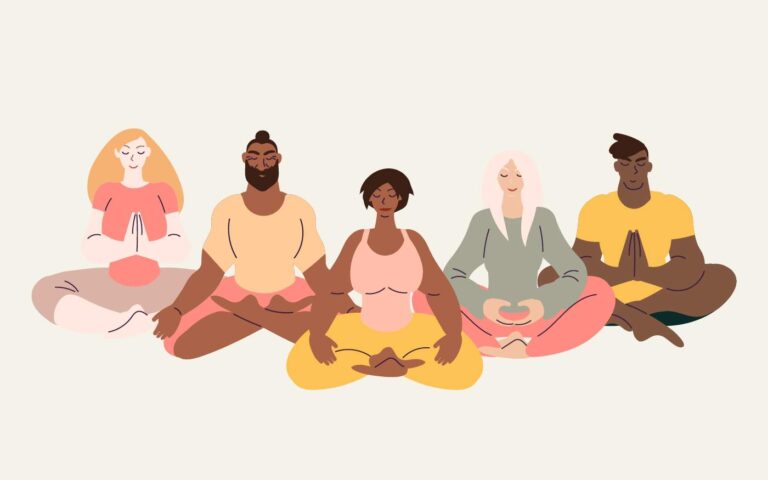“`html
Summary
What Is Mindfulness? This is the method of staying completely engaged and aware of your current surroundings—without reacting excessively or becoming lost in your thoughts.
Core Concept: Mindfulness is an inherent human capability that you can develop and enhance through techniques like seated, walking, standing, or moving meditation.
Benefits: Practicing mindfulness boosts concentration and productivity, lowers stress levels, increases self-awareness, and promotes kindness towards oneself and others.
Practical Insights:
- Everyday Integration: You can incorporate mindfulness into your daily life by taking short breaks or combining it with physical activities like yoga or sports.
- Mind-Body Connection: Mindfulness meditation starts with bodily awareness; understanding your physical stance and sensations is crucial.
Meditation Posture Tips:
- Choose a comfortable surface to sit on (like a chair, cushion, or bench), with your feet firmly on the ground or legs crossed comfortably.
- Maintain a naturally curved spine, relaxed shoulders, and slightly lowered chin. Keep your gaze gentle.
- Concentrate on your breathing and gently redirect your focus when distractions occur.
What Is Mindfulness?
Mindfulness. It’s a straightforward concept. It signifies that your mind is fully engaged with your current situation, activity, and environment. This may seem insignificant, yet it’s frustrating how often we drift away from the present moment. Our minds wander, we disconnect from our bodies, and soon we are lost in worries about the past or future, leading to anxiety.
Mindfulness is the fundamental human ability to be fully engaged and aware of our surroundings and actions without excessive reactions.
However, whenever we find ourselves lost in thought, mindfulness can bring us back to the present moment and our feelings. To truly understand mindfulness, it’s beneficial to experience it directly. Since it’s hard to describe, definitions may vary across books, websites, and other media.
The Definition of Mindfulness
Mindfulness is the essential human ability to remain fully engaged in the moment, aware of our present location and activities, without becoming overly reactive or overwhelmed by our surroundings.
This quality is something we naturally possess; there’s no need to create it; rather, we just need to learn how to access it.
The Types of Mindfulness Practice
Although mindfulness is a natural state, you can develop it using effective techniques. Here are some examples:
- Seated, walking, standing, and moving meditations (it’s possible to meditate while lying down, though it often results in sleep);
- Incorporating brief pauses into your daily life;
- Blending meditation practices with other physical activities, such as yoga or sports.
The Benefits of Mindfulness Practice:
While meditating, it’s best not to focus solely on the benefits, but rather to engage in the practice. Nevertheless, numerous advantages exist, which is why many people pursue it.
With mindfulness, we minimize stress, boost performance, attain insights through self-observation, and enhance our attention to the welfare of others.
Mindfulness meditation allows us a break from judgment, igniting our natural curiosity about mental processes while approaching experiences with warmth and kindness toward ourselves and others.
8 Facts About Mindfulness:
- Mindfulness isn’t mysterious or foreign. It’s something we all experience because it’s our natural state. It takes various forms and is known by many names.
- Mindfulness isn’t an additional task we must adopt. We already possess the ability to be present without changing who we are. However, we can enhance these innate qualities through practices proven to benefit ourselves and those around us.
- No need for transformation. Approaches that demand we alter our identity often fail. Mindfulness embraces and nurtures the best parts of our humanity.
- Mindfulness could become a transformative social movement. Here’s how:
- Accessible to everyone. Mindfulness cultivates universal human traits without necessitating belief changes. Its benefits are attainable and easy to learn.
- A way of living. More than mere practice, mindfulness infuses awareness and compassion into our lives, reducing unnecessary stress. Even small doses of mindfulness can improve our lives significantly.
- Supported by evidence. We need not accept mindfulness on faith alone; both scientific research and personal experience reveal its health and relationship benefits.
- Stimulates innovation. In a world filled with complexities and uncertainties, mindfulness can guide us toward effective, resilient, and low-cost solutions to persistent issues.
Mindfulness Is Not All in Your Head
When we think of mindfulness and meditation (with a capital M), we often get caught up in contemplating our thoughts, as if our bodies are merely containers for our minds. However, focusing solely on thoughts neglects the essential connection to our physical selves.
Staying mentally focused without grounding in our body lacks the presence of physicality.
Meditation’s essence encompasses the body. It necessitates dedicating time to acknowledge our present circumstances and thoughts.
This mindset can create an illusion of effortless drifting, somewhat like hovering instead of walking.
Yet, meditation is rooted in the body; it begins and concludes there. It means taking a moment to acknowledge our presence and surroundings, starting with bodily awareness. Just this acknowledgment can soothe us, as our bodies possess intrinsic rhythms that aid relaxation when allowed the opportunity.
How to Sit for Meditation Practice
This posture technique can serve as a starting point for a meditation session or as a brief activity to stabilize and relax before resuming daily life. If you have any injuries or physical limitations, feel free to adapt this guidance to fit your needs.
- Find your spot. Whether you’re on a chair, meditation cushion, or bench, choose a location that offers a firm, stable seat, avoiding perching or…
“““htmlRelax and Center Yourself
- Be mindful of your leg position. If you’re sitting on a cushion, cross your legs comfortably in front of you. (Feel free to assume a seated yoga posture if you prefer.) If you’re on a chair, ensure your feet are flat on the floor.
- Align your upper body. Keep your spine straight but relaxed. Allow its natural curves to exist. Your head and shoulders should rest comfortably above your spine.
- Align your upper arms with your body. Let your hands rest gently on your thighs. Your arms should be by your sides; placing your hands too far forward may cause hunching, while positioning them too far back may create stiffness. Aim for a gentle balance, tuning your body like the strings of an instrument—not too tight, not too loose.
- Lower your chin slightly and let your eyes gaze downward. You can let your eyelids relax; if you prefer, you can close them completely, but it’s not a requirement for meditation. Simply allow your visual surroundings to exist without concentrating on them.
- Take a moment to settle in. Relax and focus on your breath or the sensations in your body.
- Start the process again. Once you’re comfortable in your position, pay attention to your breath as it moves in and out. (Some methods place more focus on the exhale, allowing a pause before the inhale.) Your mind may wander; when you notice, gently bring your focus back to your breath. Avoid self-judgment regarding your thoughts. Just notice, then return.
- That’s all there is to it. This practice is often described as simple, though it can be challenging. The key is consistency. With time, you’ll see progress.
Beginner’s Mindfulness Meditation:
A Quick 5-Minute Breathing Meditation to Foster Mindfulness. This exercise aims to alleviate stress, anxiety, and negative feelings, help you calm down during moments of anger, and enhance your focus.
Expand Your Knowledge of Mindfulness:
Discover the research behind mindfulness, learn the basics of meditation, explore mindful movement techniques, and clear up common misconceptions with the Mindful’s Getting Started Guide.
Practicing Mindfulness
Increase your awareness of your surroundings and actions without becoming overly reactive or feeling overwhelmed.
Read More5 Easy Mindfulness Practices for Everyday Life
Your daily tasks present numerous chances to practice mindfulness at any moment. These straightforward techniques will bring more awareness into your routines.
Read MoreHighlighted Mindful Products
“`


